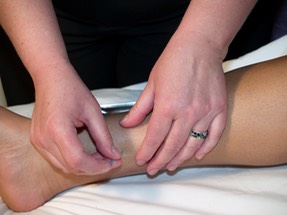
Benefits of Trigger Point Dry Needling:
- Gets rid of pain from head to toe
- Reduces knots in muscles
- Improves muscle function
- Improves biomechanics
- Improves athletic performance
- Releases tight muscles
- Speeds healing time
- Stimulates blood flow at a deep level
- Stimulates a muscle to work better
- Prevents injuries from occuring
- Heals chronic injuries of muscles, tendons and joints
What is Trigger Point Dry Needling?
Trigger Point Dry Needling (TPDN) uses small filament needles to deactivate trigger points and lengthen tight muscles. It is sometimes called functional dry needling, which means that the ultimate goal is to not just treat the pain, but to focus on the dysfunctional movement pattern that created the pain. Treatment likely affects the immune, inflammatory, biomechanical, vascular and neurological systems.
Dr. May a Denver sports chiropractor certified to perform dry needling by Kinetatore. You can watch a video of Terry Bradshaw's "The Edge" featuring Kinetacore and Dry Needling to learn more about the technique.
What is a Trigger Point?
A trigger point is defined as a hyperirritable sport found within a taut band of muscle or within muscle’s fascia. It is usually painful upon compression and can give rise to characteristic pain, referred tenderness, and/or motor dysfunction.
How is this Different from Acupuncture?
The similarity to acupuncture is the usage of fine-filament needles. TPDN is a technique used to treat neuro-musculoskeletal systems based on pain patterns, muscular dysfunction and other orthopedic signs and symptoms. The location of the needling is dependent upon the physical examination and movement assessment. In contrast, acupuncture is based on traditional Eastern Medicine and the examination involves evaluating tongue and pulse.
Will it Hurt?
Most patients will not even feel the needle penetrate the skin, but once it has and is advanced into the muscle, the discomfort can vary drastically. Usually a healthy muscle feels very little discomfort upon insertion of the needle; however, if the muscle is sensitive and shortened or has active trigger points within it, the subject may feel a sensation much like a muscle cramp -- which is often referred to as a 'twitch response’. The twitch response also has a biochemical characteristic to it which likely affects the reaction of the muscle, symptoms and response of the tissue. The patient may only feel the cramping sensation locally or they may feel a referral of pain and/or similar symptoms for which they are seeking treatment. A reproduction of their pain can be a helpful diagnostic indicator of the cause of the patient's symptoms. Patients soon learn to recognize and even welcome this sensation, as it results in deactivating the trigger point, reducing pain and restoring normal length and function of the involved muscle.
How long until I see the results?
Typically, positive results are apparent within 2-4 treatment sessions but can vary depending on the cause and duration of the symptoms and overall health of the patient. This treatment is extremely effective for whiplash conditions associated with auto accidents.


